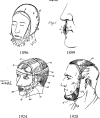Review of oral appliances for treatment of sleep-disordered breathing
- PMID: 17136406
- PMCID: PMC1794626
- DOI: 10.1007/s11325-006-0084-8
Review of oral appliances for treatment of sleep-disordered breathing
Abstract
Between 1982 and 2006, there were 89 distinct publications dealing with oral appliance therapy involving a total of 3,027 patients, which reported results of sleep studies performed with and without the appliance. These studies, which constitute a very heterogeneous group in terms of methodology and patient population, are reviewed and the results summarized. This review focused on the following outcomes: sleep apnea (i.e. reduction in the apnea/hypopnea index or respiratory disturbance index), ability of oral appliances to reduce snoring, effect of oral appliances on daytime function, comparison of oral appliances with other treatments (continuous positive airway pressure and surgery), side effects, dental changes (overbite and overjet), and long-term compliance. We found that the success rate, defined as the ability of the oral appliances to reduce apnea/hypopnea index to less than 10, is 54%. The response rate, defined as at least 50% reduction in the initial apnea/hypopnea index (although it still remained above 10), is 21%. When only the results of randomized, crossover, placebo-controlled studies are considered, the success and response rates are 50% and 14%, respectively. Snoring was reduced by 45%. In the studies comparing oral appliances to continuous positive airway pressure (CPAP) or to uvulopalatopharyngoplasty (UPPP), an appliance reduced initial AHI by 42%, CPAP reduced it by 75%, and UPPP by 30%. The majority of patients prefer using oral appliance than CPAP. Use of oral appliances improves daytime function somewhat; the Epworth sleepiness score (ESS) dropped from 11.2 to 7.8 in 854 patients. A summary of the follow-up compliance data shows that at 30 months, 56-68% of patients continue to use oral appliance. Side effects are relatively minor but frequent. The most common ones are excessive salivation and teeth discomfort. Efficacy and side effects depend on the type of appliance, degree of protrusion, vertical opening, and other settings. We conclude that oral appliances, although not as effective as CPAP in reducing sleep apnea, snoring, and improving daytime function, have a definite role in the treatment of snoring and sleep apnea.
References
-
- {'text': '', 'ref_index': 1, 'ids': [{'type': 'PubMed', 'value': '15187032', 'is_inner': True, 'url': 'https://pubmed.ncbi.nlm.nih.gov/15187032/'}]}
- Hoekema A, Stegenga B, De Bont LG (2004) Efficacy and co-morbidity of oral appliances in the treatment of obstructive sleep apnea–hypopnea: a systematic review. Crit Rev Oral Biol Med 15:137–155 - PubMed
-
- {'text': '', 'ref_index': 1, 'ids': [{'type': 'PubMed', 'value': '12800789', 'is_inner': True, 'url': 'https://pubmed.ncbi.nlm.nih.gov/12800789/'}]}
- Ferguson KA (2003) The role of oral appliance therapy in the treatment of obstructive sleep apnea. Clin Chest Med 24:355–364 - PubMed
-
- {'text': '', 'ref_index': 1, 'ids': [{'type': 'PubMed', 'value': '12733777', 'is_inner': True, 'url': 'https://pubmed.ncbi.nlm.nih.gov/12733777/'}]}
- Mohsenin N, Mostofi MT, Mohsenin V (2003) The role of oral appliances in treating obstructive sleep apnea. J Am Dent Assoc 34:442–449 - PubMed
-
- {'text': '', 'ref_index': 1, 'ids': [{'type': 'PubMed', 'value': '11699239', 'is_inner': True, 'url': 'https://pubmed.ncbi.nlm.nih.gov/11699239/'}]}
- Ivanhoe JR, Attanasio R (2001) Sleep disorders and oral devices. Dent Clin North Am 45:733–758 - PubMed
-
- {'text': '', 'ref_index': 1, 'ids': [{'type': 'PubMed', 'value': '11392605', 'is_inner': True, 'url': 'https://pubmed.ncbi.nlm.nih.gov/11392605/'}]}
- Lindman R, Bondemark L (2001) A review of oral devices in the treatment of habitual snoring and obstructive sleep apnoea. Swed Dent J 25:39–51 - PubMed
Publication types
MeSH terms
LinkOut - more resources
Full Text Sources
Other Literature Sources
Medical


